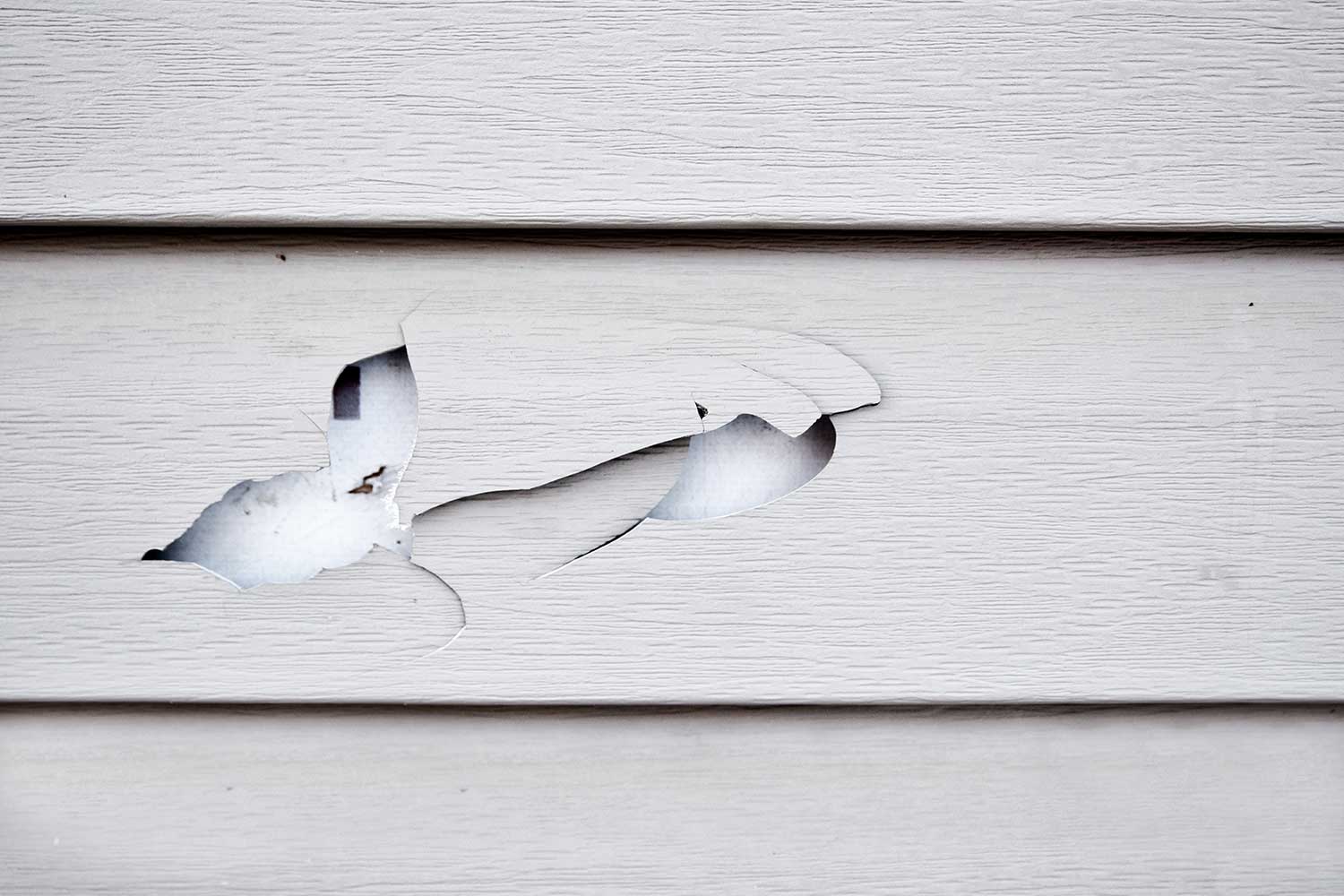Vinyl siding comes in a variety of colors and styles. It is affordable, attractive, strong, and water-resistant. Even though it is durable, a stray rock thrown by a lawnmower or some other unfortunate accident could leave you with a hole in your siding. How can a hole in vinyl siding be repaired? We've done some research and have a guide for you.
To fix a hole in vinyl siding, you'll need to take the following steps:
- Clean and prep the area around the hole
- Prep a caulk gun with color-matched caulk
- Prep the vinyl siding patch, if needed
- Use the caulk to fill small holes or cracks
- Cover the hole with the patch or vinyl siding using caulk or screws
- Use a utility or box knife to scrape away any excess caulk
- Paint if needed
Now that you know the basic steps to repair a hole in vinyl siding, let's go over each step in more detail. We'll give you all the important facts, as well as answer some other questions you might have. Continue reading!
![Low angle view of soffit, gutters, downspout and vinyl siding on a new home, How to Fix a Hole in Vinyl Siding [7 Steps]](https://uooz.com/wp-content/uploads/2021/01/How-To-Fix-A-Hole-In-Vinyl-Siding.png)
How To Fix A Hole In Vinyl Siding

Required Materials
The first step to any project is getting the proper equipment. Having everything you need within arm's reach will prevent a lot of frustration when you're in the middle of your project. To patch a hole in vinyl siding, you'll need:
- Medium grit sandpaper
- Mild soap and water solution or rubbing alcohol
- Clean sponge or cloth
- Prefabricated vinyl siding patch or an extra piece of scrap vinyl siding
- Paint matching your vinyl siding (optional)
- Colored caulk and caulk gun
- Screws and a power drill (optional)
- Putty or utility knife
You can choose to cover your hole using some leftover vinyl siding from installation, if you have it, or purchase a small piece from any home store that sells vinyl siding.
Alternatively, you can purchase a patch to cover the hole. If you purchase the patch, keep in mind you'll need to purchase paint matching the color of your vinyl siding. Some holes will be minor enough just to use color matching caulk to fill them. This method works especially well with small cracks.
1. Clean and prep the area around the hole
If you're planning on covering the hole with an adhesive patch, you have the option of filling the hole with low expansion foam. Before filling the hole with the foam, ensure you aren't near any electric wires or plumbing. Most insulation foam dries and cures within about 12-24 hours.
Once the foam is cured, sand it until it's smooth, then proceed. By adding this extra step, it gives the vinyl patch an even area on which to adhere.
Click here to see this low expansion foam on Amazon.
To ensure the best fit, you must ensure the area around the hole is free of jagged edges and is clean. Using medium grit sandpaper, work at any jagged or uneven edges around the hole until the area is smooth.
Clean the area with rubbing alcohol and a clean cloth or by using mild dishwashing detergent and water. The area must be clean and dry before proceeding.
Click here to see this sandpaper on Amazon.
2. Prep a caulk gun with color-matched caulk
If you're using an adhesive vinyl patch, caulk won't be necessary, so you can skip this step.
Insert your caulk container into a caulk gun. Ensure you've purchased a color that matches your vinyl siding. You can purchase colored caulk at any retailer that sells vinyl siding.
Click here to see this caulk gun on Amazon.
3. Prep the vinyl siding or patch, if needed
If using a vinyl siding patch, trim it to fit over the hole. Be sure to leave enough overlap over the hole to fully cover it and ensure it has ample space to grip. These patches at made of durable PVC and, if adhered well and allowed to fully cure, keep out excess moisture all while blending it into the vinyl.
Click here to view these vinyl siding patches on Amazon.
If using an extra piece of vinyl siding, cut off the uppermost edge (nail hole strip) of the scrap vinyl siding and leave the curved lip. Cut off the bottom edge as well, also leaving the curved lip. Fit the patch over the hole in the siding to ensure a good fit. The curved edges should provide grip over the existing siding. If necessary, trim the edges further if the fit isn't great.
4. Use the caulk to fill small holes or cracks
If you're simply filling a tiny hole or cracks in the vinyl siding, use the caulk gun to fill the holes and cracks. Use a putty knife to smooth the caulk to an even finish. It's best to do this project on a sunny day, as the caulk needs to fully dry. If the damage was small enough, this could be the end of your repair.
Click here to see this putty knife on Amazon.
Want to know how to hang things from vinyl siding? Read our post about that: How To Hang Things On Vinyl Siding (Even Without Nails)
5. Cover the hole with the patch or vinyl siding using caulk or screws
If using the patch, peel off the backing to expose the adhesive. The best application method is to start at the bottom of the hole, press upward, and smooth by pressing firmly. Continue pressing if there are any air bubbles. A proper adhesion should assist in revealing any texture beneath the patch.
If using scrap vinyl, use the caulk around the hole and on the back of the piece of vinyl. Adhere the vinyl over the hole and click into place. If desired, you may use a power drill and screws on the bottom of the vinyl scrap piece to ensure secure attachment.
One thing to note when using scrap vinyl -- the visual might not be as smooth as with using a patch or filling small holes with caulk. The edges of this vinyl scrap will be visible.
Click here to see this power drill on Amazon.
6. Use a utility or box knife to scrape away any excess caulk
If necessary, use a utility knife to remove any excess once the caulk has dried. Most caulk is touch-dry within about half an hour but can take longer to fully cure. If you used caulk to fill the hole, you can use sandpaper to remove excess caulk as well. Be sure to scrape away any excess caulk around the edges of your scrap vinyl as well.
Click here to see this knife on Amazon.
7. Paint If Needed
If you used a patch, once it is fully dried, you will need to paint over it. Match your siding color as closely as possible, and then use a feathering technique to paint over the patch. It is recommended to allow the patch to set for at least a few hours before applying paint. Allow the first coat to fully dry and then apply a second.
After all these steps are completed, you will have fixed the hole in your vinyl siding quite nicely. These fixes will last for quite a while until you wish to replace the full piece of vinyl siding.
Does vinyl siding damage easily?
Vinyl siding can be damaged, although the threat of damage isn't any greater than with many other building materials. Of course, when it comes to the outside of your home, there are a few more building materials that are tougher, such as brick or wood.
However, with wood siding, if not maintained, it could rot within a handful of years whereas vinyl is water-resistant. Unfortunately, because it is a softer material, it will get holes more easily than wood. It is worth noting that vinyl siding can last up to 60 years if properly taken care of.
Can vinyl siding be glued?
Vinyl siding can be glued using an adhesive intended to bind PVC. When purchasing glue with the intention of gluing vinyl siding, ensure that the adhesive mentions PVC on the label or in the name. Other types of glue will not have the desired effect.
Click here to see this PVC cement on Amazon.
How do you match the color of vinyl siding?

Finding siding of the same color is likely the most difficult part of repairing your vinyl siding. Even if you have some scrap vinyl from installation, weathering on your existing siding could leave the colors unmatched. Still, the closest you will get is from scrap vinyl.
If you don't have scrap vinyl, take a section of your existing vinyl to a vinyl siding retailer to try to match as closely as possible. Sometimes the piece you take could be from the hole you're trying to patch. If you can't get an exact match, try to find a paint that is close and use that over your patch once it is attached.
In Closing
Fixing a hole in vinyl siding doesn't have to be difficult. Some of the methods mentioned above require minimal tools and technical skills. Don't stress over that small hole and get to work repairing it. If nothing else, you can preserve the appearance from a distance until a full replacement can be done.
Ready to replace your siding? Read our article, How Much Does It Cost To Side A 1,500 Sq Ft House?








